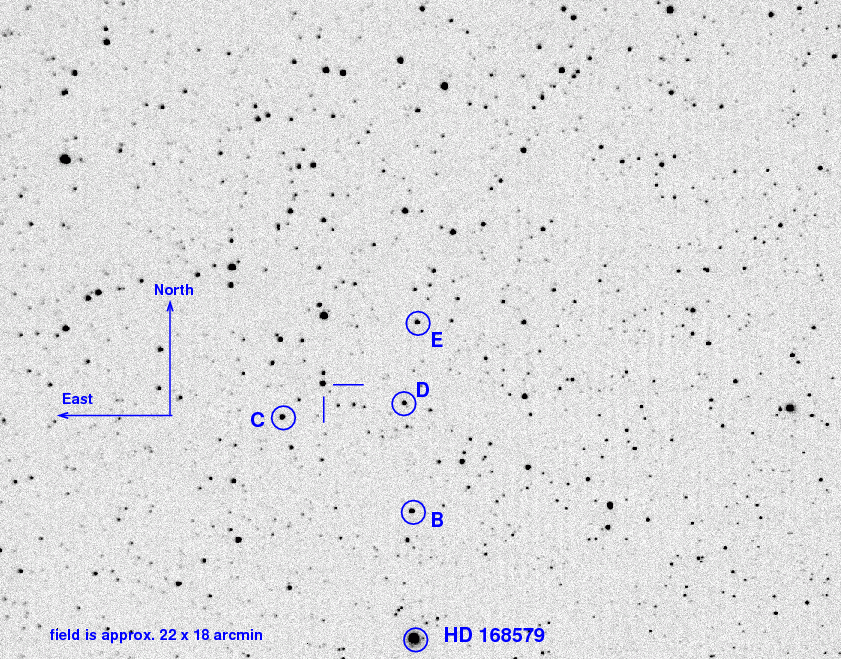
On the night of Jun 13/14, 2018, from about 10:40 PM until dawn, through beautiful skies, I acquired a set of observations of the likely black-hole system MAXIJ1820+070, (also known as ASASSN-18ey ).
I discovered that the azimuth position of the mount still needs more adjustment. Rats.
The main setup was:
Notes from the night:
This optical and X-ray and radio transient is likely a black hole accreting material at a higher-than-usual rate. It has been the subject of many observers over the past few months -- see the trail of telegrams that include
The object is located at
RA = 18:20:21.9 Dec = +07:11:07.3
A chart of the field is shown below. The size of the chart is about 22 by 18 arcminutes.
I've marked the location of several comparison stars, which also appear in light curves below. Stars C, D, and E are mentioned by the Tomoe Gozen team in ATel 11426, but all three are rather red, with (B-V) ranging from 1.14 to 1.37. Star B is one of the bluest nearby bright stars, with (B-V) = 0.52.
star UCAC4 B V ---------------------------------------------------- B 486-079513 12.975 12.454 C 486-079608 13.968 12.830 D 486-079523 14.637 13.272 E 487-077858 14.637 13.272 ----------------------------------------------------
The dark current was pretty ordinary.

The sky value shows clear skies all night.

Here's a record of the telescope's drift. I made several adjustments near the meridian crossing (around 2 AM = JD 283.75). I turned the azimuth knob CCW by a total of 3 bumps, but did it help? It's not clear -- maybe I made the Dec drift at this time worse.
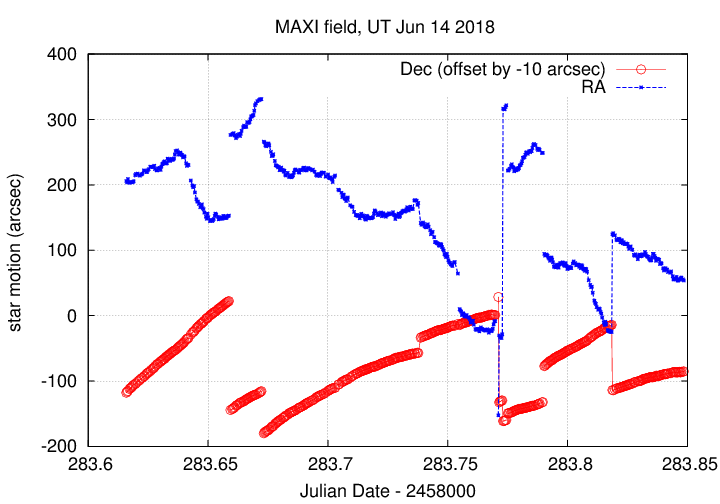
The number of objects detected -- I required 50 objects for an image to be included in the ensemble.
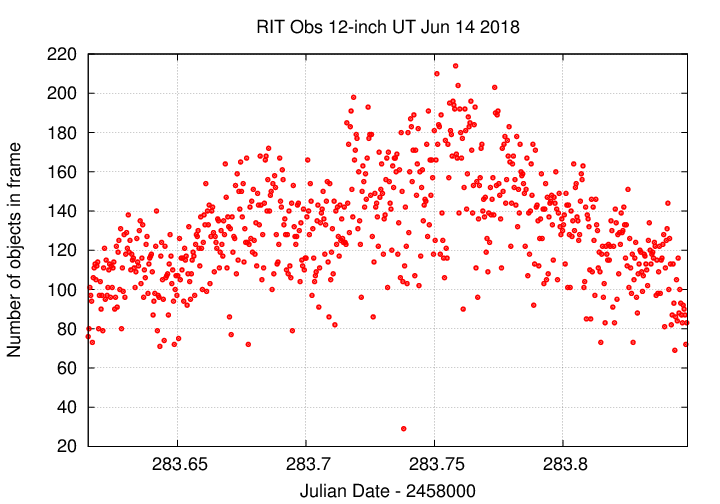
I used an aperture with radius 5.0 pixels. I adjusted the focus position from 0.799 -> 0.810 -> 0.831 as the temperature dropped, and that did improve the PSF. So, when temperature DECREASES, the focus position INCREASES.

I added one facet to the analysis tonight: I discarded images which had obvious trailed stellar images, (about 100 of the 700 raw images), and also removed outliers in the image adjustment graph. The resulting ensemble shows a very clean image adjustment graph.
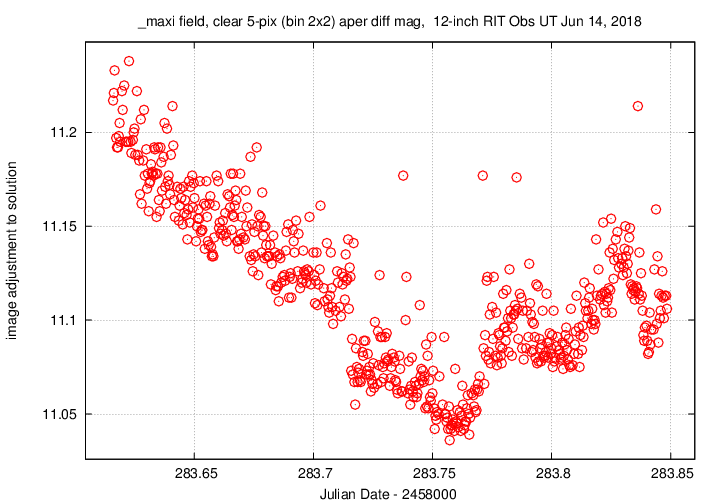
Using aperture photometry with a radius of 5 pixels (binned 2x2, each pixel is 1.34 arcsec, so a radius of 6.7 arcsec), I measured the instrumental magnitudes of a number of reference stars and the target. Following the procedures outlined by Kent Honeycutt's article on inhomogeneous ensemble photometry, I used all stars available in each image to define a reference frame, and measured each star against this frame.
Sigma-vs-mag plots show that the floor was about 0.006 mag overall, which is very good. The outlier around instrumental magnitude 2.9 is MAXI J1820+070.
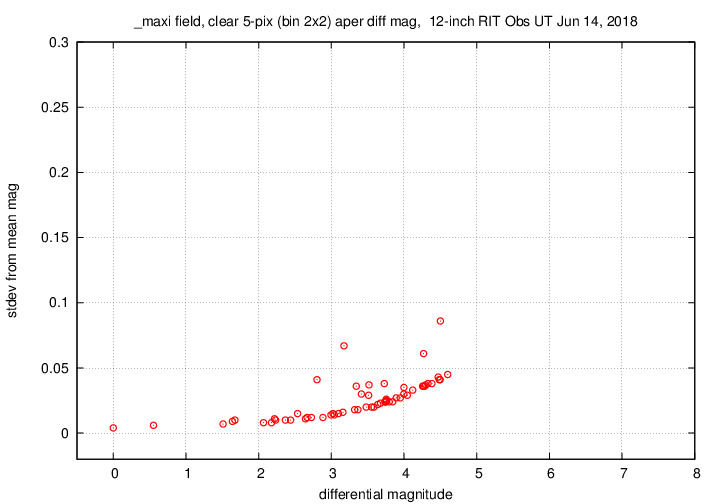
Here are light curves of the variable and the field stars.
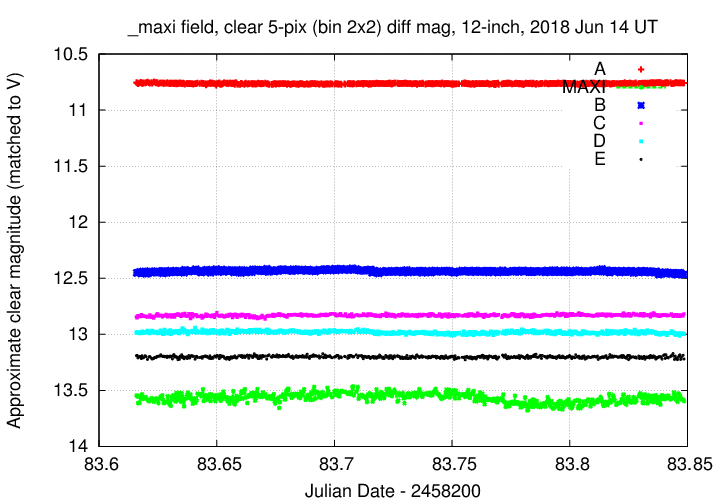
I used the UCAC value for the V-band magnitude of star "B" = UCAC4 486-079513 to shift the ensemble magnitudes to the standard V-band scale -- but remember that these are UNFILTERED measurements.
Here's a closeup on the variable. I'll connect the dots to make its behavior a bit easier to see.
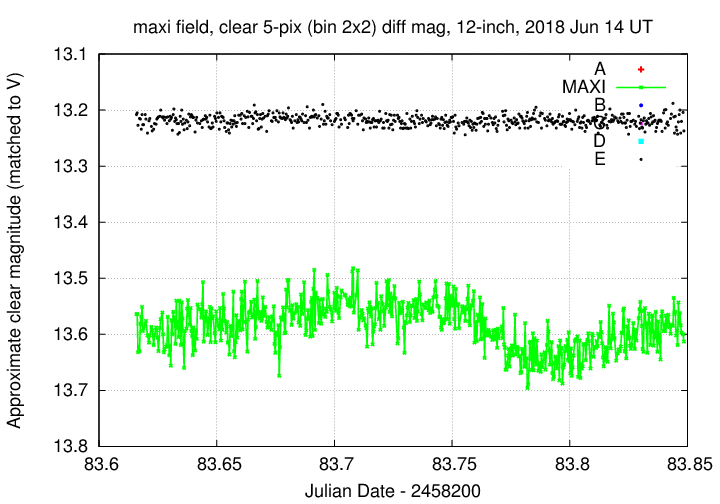
You can download my measurements below. A copy of the header of the file is shown to explain the format.
# Measurements of MAXIJ1820+070 made at RIT Obs, UT 2018 Jun 14, # in very good conditions, # by Michael Richmond, # using Meade 12-inch LX200 and ATIK 11000. # Exposures 25 seconds long, no filter. # Tabulated times are midexposure (FITS header time - half exposure length) # and accurate only to +/- 1 second (??). # 'mag' is a differential magnitude based on ensemble photometry # using a circular aperture of radius 5 pix = 6.6 arcseconds. # which has been shifted so UCAC4 486-079513 has mag=12.454 # which is its V-band magnitude according to UCAC4. # # UT_day JD HJD mag uncert Jun14.11591 2458283.61591 2458283.62083 13.564 0.012 Jun14.11623 2458283.61623 2458283.62115 13.564 0.012 Jun14.11656 2458283.61656 2458283.62148 13.632 0.013
Last modified 6/15/2018 by MWR.